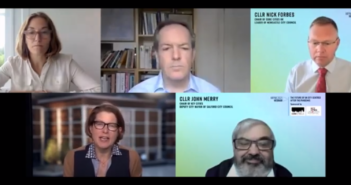Two weeks ago, I participated in a panel session at the United Nations’ World Urban Forum about the value of culture in relation to our global sustainable development goals. These 17 goals, introduced by UN Habitat and ratified by all member countries and organisations, advocates that by 2030 the world will be less hungry, wealthier, more sustainable and environmentally friendly. The panel I participated in was the first that discussed the role of culture and my role, to introduce music into the topic, was also new to a United Nations forum. Speaking on the panel, it made me realise that to achieve these goals and create a better, more sustainable world for all of us, we have to ensure this conversation is framed on two core things we all share – culture and land. For the global real estate sector, I believe there’s a missed opportunity in using music to increase value, create better communities, engage local residents and generate better outcomes. Now, as MIPIM approaches, I want to justify why I think this is the case and why every landowner and investor should prioritise culture alongside everything else, not only to improve our overall surroundings, but to increase one’s return on investment.
To explain this, let’s start with an analogy. Each city, neighbourhood and development, wherever we live and whatever we do, can be compared to a garden. For a garden to be successful and for plants to thrive and fruit, we need to first get the soil right. This involves introducing nutrients that feed the good bacteria and starve the bad – essentially engage the best elements of the soil to enrich the plants and produce results. If we look at each development in this way, the strategy and policy underpinning each decision made is the soil – from a master plan to planning permission, layout and blueprints. And within this strategy, one element often touched upon but not wholly strategised is culture, and music in particular.
With music as a communicator and reference, it significantly improves the make-up of the soil (i.e community) and lays the groundwork for better outcomes, be they financial, social or cultural. Many developers in the world over utilise the power of music to sell ideas, dreams and aspirations – from the rebranding of a jazz club in central London to sell luxury apartments to the inclusion of significant music infrastructure in the redevelopment of an area of town, such is the case in Huntsville, Alabama. But this is not so much reaping the rewards of the soil, but more taking healthy cuttings from existing plants. A music strategy – for real estate – can do much, much more.
When embedded at the earliest stages of the development, it can identify what music and culture exists around a particular site, to identify what to best support, who to best engage and what culture is more communicable to developing better stakeholder relations. When incorporated into community strategies, it supports citizen engagement and over time, establishes better relationships with authorities and the greater creative community – other plants in the garden. And music, unlike other artforms, is a universal communicator. It is the global universal language (not English) and it is cross-generational. Staging events with music brings in old and young; supporting music education improves cognitive ability, which leads to greater engagement, and it is a tool to increase social inclusion and upward mobility. This can be done by planting the right seeds – a venue here, a studio there, or perhaps a community rehearsal space or art centre. But these seeds need nourishment and without understanding what’s around the development and inventorying local culture, the garden becomes starved and the buildings fail to serve the community.
In addition, music is the ultimate regeneration tool. Musicians, as well as artists and designers are often first to identify growth areas. But once an area develops, it often gentrifies to the point the musicians are unable to live there. The garden fruits, but then it dies – and what the area is sold on becomes singular and cultureless. A defined, intentional and deliberate music strategy – at the earliest stages – identifies these challenges before they occur, which improves relationships and can protect cultural agents of change. And these creators, through their placemaking abilities, will increase value and deliver yield. Encouraging and supporting them creates better communities ten, fifteen, twenty years down the line.
And when this succeeds, the garden becomes perennial and the city, town, development or scheme benefits. It increases long-tail yield. It encourages more innovative meanwhile uses and importantly, it fosters community cohesion. It delivers on our sustainable development goals, and a world that is working to become more efficient, healthier and more diverse as it gets denser and more competitive will lift all of us up, with landowners benefitting alongside.
But all this has to start somewhere. First we need to recognise that like a land-use policy, or a meanwhile policy, all schemes need a music policy. Without it, none of this is strategised, making it harder to achieve. And as our cities grow, this will become increasingly important to maintain competitiveness and appeal to graduates, entrepreneurs and wealthy retirees, all concerned about a place’s cultural offer as a key indicator of livability.
So start now. You need a music policy. Nurture the soil properly now. Increased economic, social and cultural benefits will be your reward.
Shain Shapiro will be at MIPIM 2018 to talk about Leisure in the City!
Top photo © Siwawut/GettyImages



